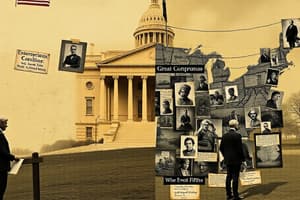Podcast
Questions and Answers
What was the Northern states' argument regarding the representation of slaves?
What was the Northern states' argument regarding the representation of slaves?
- Slaves should be counted for representation.
- Slaves should not be counted unless they were free citizens. (correct)
- Slaves should be taxed like property. (correct)
- All of the above.
What was the Three-fifths Compromise?
What was the Three-fifths Compromise?
The Three-fifths Compromise was an agreement that slaves would be counted as three-fifths of a person for representation purposes in Congress.
The Southern states wanted slaves to be counted only if they could vote.
The Southern states wanted slaves to be counted only if they could vote.
False (B)
What concerns did the South have about Congressional powers?
What concerns did the South have about Congressional powers?
What was the Northern stance on slavery by 1787?
What was the Northern stance on slavery by 1787?
Which two exceptions did the compromise state regarding Congressional powers?
Which two exceptions did the compromise state regarding Congressional powers?
Flashcards are hidden until you start studying
Study Notes
The Slave Debate
- Northern and Southern states clashed over counting slaves for Congressional representation.
- Southern states aimed to increase representation by counting slaves, while Northern states opposed this due to the lack of voting rights for slaves.
The North's Argument
- Northerners argued against counting slaves to prevent Southern states from gaining unfair representation.
- They insisted that enslaved individuals should be taxed like other property unless granted citizenship and voting rights.
The South's Argument
- Southern states argued that slaves should be counted for representation as their economy relied heavily on slave labor.
- Most Southerners were farmers dependent on slaves for effective farm operation, leading to a reluctance to free them.
The Three-Fifths Compromise
- The compromise established that slaves would be counted as three-fifths of their actual number for representation (3 out of every 5 slaves).
- This agreement aimed to resolve the debate over slave counting in relation to House representation.
Public Sentiment on Slavery
- By 1787, many Northern states had abolished slavery, seeking to end it nationwide.
- The North wished for Congress to gain powers to regulate trade, raising fears in the South that this would threaten slavery.
Other Southern Concerns
- The South worried that Congress's regulatory powers could lead to taxes on exports like rice and tobacco, impacting their economy.
Delegate Compromises
- Congress was allowed to regulate trade but with two significant limitations:
- No taxation on exported goods.
- No interference in the slave trade or slavery for 20 years, until 1808.
- The Fugitive Slave Clause was included, granting Southern states the right to reclaim escaped slaves.
Studying That Suits You
Use AI to generate personalized quizzes and flashcards to suit your learning preferences.





